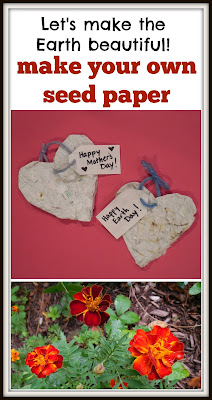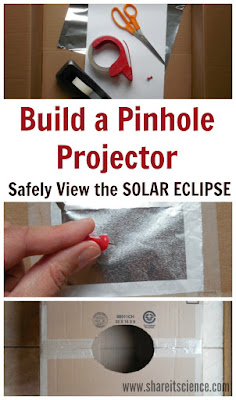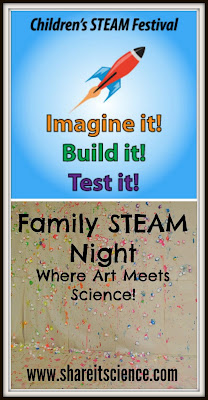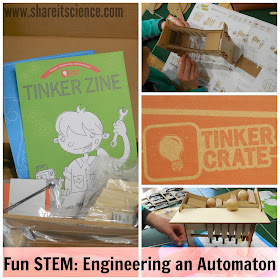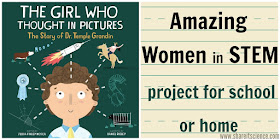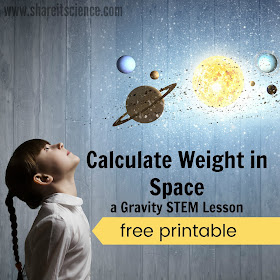I'll be taking a brief hiatus from writing any new blog posts as I work towards improving the Share it! Science site. In the new year the site will undergo a facelift, and get some behind-the-scenes updates that will improve the way readers navigate the site. You can also look forward to a regular newsletter that will be full of science, STEM and STEAM resources. There will continue to be content added to the site regularly, just as you've come to expect. I'm really excited about the changes and hope you stick around to see what is in store for us in 2018!
In case you missed these science, STEM and STEAM activities, here are the 10 most visited posts from the past year. Some are new, a few are oldies but goodies that continue to pique the interest of science teachers, homeschool families, and parents who love providing hands-on learning fun for their kids.
1. Year of the Solar Eclipse!
This past summer, the United States went eclipse crazy! Due to that, I had my first viral post: Everything You Need to Know About the Great American Solar Eclipse
It included resources for finding out where and when the eclipse could be viewed, as well as safe viewing practices. Although it is rare that so many are able to witness a solar eclipse across the U.S.A. we'll have another opportunity in 2024, so tuck this post away again until then!
If you are interested in astronomy or want to teach kids more about it, you'll also want to visit these posts:
- Watch the Perseid Meteor Shower: Resources for Enjoying the Night Sky at Any Age
- Connecting Kids with Scientists: Story Time from Space
- May the 4th Be With You: Star Wars Astronomy
2. DIY Zoetrope STEAM Project
Early in 2017 I wrote this post about making your own zoetrope to create animation as part of a "A-Z STEM" series. Z was for Zoetrope! It quickly became one of my most popular posts of all time and is still very popular on the blog. If you love hands-on projects for kids this is one that will keep them engaged for hours!
If this project looks intriguing you'll also want to explore:
- A Patriotic Spin on the Zoetrope Animation STEAM Project (for 4th of July)
- STEAM Opportunity: Kid Vid Fest Stop Motion Animation Film Festival
- Hands-on, Minds-on Fun Learning with STEAM Kids!
3. DIY Recycled Seed Paper
This older post has been a favorite on the blog for 2 years now. It is a tutorial for making your own recycled paper, infused with seeds. You can plant the paper right in the ground or a pot and grow flowers. It's not only a fun activity to help kids learn to recycle and about nature, but also makes a great homemade gift!
If you like DIY projects for the kids, or enjoy nature and gardening with children, you won't want to miss these activities:
- Valentine's Day is for the Birds: Make a Bird Treat
- Grow an Alphabet Themed Kid's Garden
- Grow a Rainbow or Butterfly Children's Garden
4. Safe and Easy Projects for Little Spies and CSIs
Another oldie but goodie, the post "Spies and CSIs" has been a hit for a long time. It includes directions for 2 different invisible ink projects, that don't need candles or a heat source, and a version of fingerprinting that does not require ink. Great for a rainy afternoon, your students or children can create secret messages and a fingerprint database with materials you most likely have on hand already.
If your students or children love hands-on science activities like Spies and CSIs with materials that are easy to find, then you should definitely check out these posts:
- Give the Gift of a Hands-On Science Experience
- Make pH Paper with Poinsettia Leaves (Christmas Science)
5. Learn to Conserve: Build a Landfill Model
I designed this conservation lesson around a children's book for a Storybook Science series earlier in the year. In "Here Comes the Garbage Barge" Inspired Landfill Model you can learn where all of the trash we generate goes and how a landfill works by building a model. I used this lesson many times when teaching 3rd grade science and it was always a fun eye-opener for my students.
If you teach conservation at home or school, you'll want to learn more about these green resources:
- TerraCycle: Recycle "Un-Recyclable" Items and Make $ for Your School or Non-Profit!
- Favorite Picture Books from the 2017 Green Earth Book Awards
6. DIY Pinhole Projector to Safely View the Solar Eclipse
This DIY for building a pinhole projector to view the solar eclipse was very popular this summer as well. This is a great project for kids who like to build things. It requires simple materials and is a great lesson in optics as well as functioning as a tool for eclipse viewing.
To learn more about solar eclipses, or cool DIY projects, check out these links that I've also shared above:
- Everything You Need to Know About the Great American Solar Eclipse
- DIY Zoetrope Animation STEAM Project
7. Teaching Kids to Code
Teaching kids how to code can help them develop important problem-solving and sequencing skills. This post on different ways to teach kids coding with and without a computer continues to be a popular one. It is a lot easier than you might think to teach these skills and it doesn't necessarily mean more screen time for kids.
If you are a STEM teacher, or any teacher or homeschool family for that matter, and are interested in educational technology, you will also find "Eduporium: A Great Resource for Educational Technology" useful.
8. Best Lesson for Teaching Water Conservation
This water conservation demo was always an eye-opening and effective lesson when I was teaching science. It clearly and easily illustrates how little fresh, clean water is available to drink, and why we must conserve water. The bonus is that it uses materials you most likely already have in your kitchen.
If you are looking for more resources for teaching conservation or teaching science and STEM in general, you'll want to investigate the following.
- Favorite Picture Books from the 2017 Green Earth Book Awards
- 30+ Science, STEM and NGSS Teaching Resources To Use This Year
- Over 70 of the Best Science Web Resources
9. Plan a Family STEAM Night at School or Home
STEAM, or the inclusion of art with the STEM disciplines of Science, Technology, Engineering and Math is a huge movement in developing curriculum that stimulates all parts of the brain and engages creative problem-solving and design skills. This popular post outlines a Family STEAM Night event I helped to organize at my school. These fun, family STEAM activities can easily be used at home or school.
If you want to learn more about STEM and STEAM you won't want to miss the following:
10. Cool Engineering Projects for Kids
Check out Tinker Crate with us in this post where we use a STEM kit to build our own automaton! A great way to engage kids in tinkering, building and engineering!
Want to get kids engineering, designing and building? Check out these posts:
- Nature Sculpture Engineering Challenges
- Children's STEAM Festival: Rube Goldberg Machines- An Engineering Challenge
- Roller Coasters and Outer Space: Gravity Activities for Kids (Design a Marble Roller Coaster)




